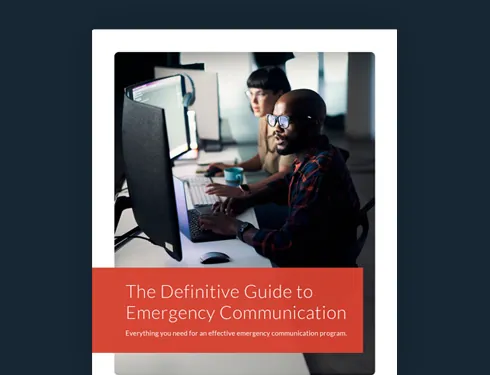
From Chaos to Control: How ISO 22320 Strengthens Emergency & Incident Response
When disaster strikes—whether through cyberattacks, natural disasters, or political unrest—ISO 22320 provides the structured, coordinated response needed to replace chaos with control.

In today’s increasingly interconnected and unpredictable world, organizations face a wide range of threats to their people and operations—from cyberattacks and natural disasters to political unrest and supply chain disruptions. These risks may vary in cause and scope, but they all demand one essential capability: the ability to respond quickly, clearly, and in a coordinated manner. Without a structured plan in place, even a minor disruption can escalate into a full-blown crisis, with widespread operational, financial, and reputational consequences.
That’s where ISO 22320 comes in. This international standard for emergency management provides a comprehensive framework for managing incidents of all types. It emphasizes clear communication, defined roles and responsibilities, and seamless coordination between internal teams and external stakeholders. Whether navigating a localized emergency or a large-scale disruption, ISO 22320 helps ensure your organization is prepared to respond with clarity, efficiency, and control.
The Definitive Guide to Emergency Communication
ISO 22320:2018 Scope, Objectives, and Why It Matters
ISO 22320 (more formally titled ISO 22320:2018 Emergency Management – Guidelines for Incident Management) is a standard designed to complement an all-hazards approach to emergency response. The standard was first published in 2011 and updated in 2018. it has since been reviewed and confirmed by the International Organization for Standardization without revision in 2024.
To remain adaptable to any emergency—natural disaster, cyberattack, or health crisis—ISO 22320 emphasizes broad, flexible principles rather than prescribing responses to specific scenarios. This makes it well-suited for organizations of any size or sector.
The standard focuses on three primary principles:
- Coordination: Encourage collaboration across organizations and sectors to ensure that resources, incident information, and responsibilities are shared effectively during a crisis.
- Command and control: Establish clear leadership structures and decision-making authority for efficient and consistent emergency response.
- Information management: Promote the structured collection, analysis, and dissemination of accurate information, which is essential for informed decision-making during an incident.
ISO 22320 also includes additional supporting practices, such as resource management, public communication, and decision support, to enhance the overall effectiveness of incident response.
How other ISO standards align with the purpose of incident management
Because it’s a broad standard designed for a wide range of organizational types, ISO 22320 aligns well with other standards within the ISO 22300 group.
For example, ISO 22301 focuses on business continuity management systems, helping organizations maintain critical operations during and after disruptions. While ISO 22301 outlines what needs to be in place to continue delivering products and services, ISO 22320 supports the real-time response and coordination required when an incident occurs.
Other related ISO standards include:
- ISO 22322, which offers guidelines for public warning systems
- ISO 22324, which provides guidance on emergency message color codes
- ISO 22325, which supports exercises and testing for incident preparedness
- ISO 31000, for the development of an overall corporate risk management program
Together, these standards can form a comprehensive framework for improving organizational readiness, response, and resilience management. When used in combination, they help ensure that an organization coordinates effectively during crises and learns from incidents afterward.
In addition to ISO, national standards such as FEMA’s National Incident Management System (NIMS) in the United States, the U.K.’s Civil Contingencies Act guidance, and Australia’s Critical Infrastructure Resilience Strategy can complement ISO guidance by offering region-specific requirements and practical tools tailored to local contexts.
Balancing the Benefits and Challenges of ISO 22320
Because ISO 22320 serves as a foundational program for organizational crisis response and societal security, it offers organizations a wide range of benefits. Information gleaned from your efforts to protect your business from harm can also strengthen communication, clarify leadership roles, and improve coordination with external stakeholders.
By implementing the essential components of incident management under ISO 22320, organizations can:
- Enhance situational awareness: Structured information management helps ensure decision-makers and technical committees have accurate, real-time data during incidents.
- Improve coordination and collaboration: Clear processes and shared terminology promote cooperation across departments, agencies, or international partners.
- Establish consistent leadership structures: Well-defined command and control frameworks reduce confusion and enable faster, more effective responses.
- Support regulatory and stakeholder expectations: Adherence to international standards can help demonstrate a proactive approach to risk management and crisis preparedness.
- Build long-term resilience: Lessons learned through incident management planning and execution feed into organizational improvement and business continuity efforts.
Overall, ISO 22320 helps organizations turn crisis response into a strategic strength. Of course, like any standard, only proper implementation can help you realize its benefits. In many cases, the standard’s challenges are directly tied to that process.
As a broad standard, ISO 22320 leaves much room for interpretation. This flexibility can make it challenging to translate high-level guidance into concrete actions, especially for organizations without established incident management structures or resources for allocation. Without clear direction, teams may struggle to define roles, coordinate across departments, or align the standard with existing business continuity or emergency protocols.
Additionally, implementing ISO 22320 often requires cross-functional buy-in across the organization and incident command, consistent training, and the integration of multiple systems and processes, each of which can be a hurdle on its own. Luckily, the right crisis management strategies can help you overcome many of these hurdles and realize the benefits of the incident management process.
A Practical Guide to ISO 22320 Implementation
Creating an emergency response plan is one thing; implementing it is another challenge entirely. While it’s easy to outline procedures on paper, real-world execution often falls apart without a clear emergency communication plan, defined roles, and coordination across all levels of an organization.
To implement ISO 22320 effectively, organizations must take a strategic approach to its three core principles: coordination, command and control, and information management. These pillars are the key to bridging the gap between incident management planning and action.
In an episode of The Employee Safety Podcast, David Markley, Director of Operations at Grace Covenant Church in Austin, Texas, provides some insights into managing this. With a defense, engineering, and security background, David offers practical, on-the-ground lessons in improving emergency response and situational awareness in line with ISO 22320 best practices.
1. Build a clear incident action plan structure before the crisis hits
In the heat of the moment, predicting how people will respond is difficult, especially if they don’t know their role or what actions to take to stay safe. The time to shape your response isn’t during the emergency; it’s long before it begins.
ISO 22320 emphasizes the importance of pre-defined command and control structures to ensure clarity during emergencies. That structure is a framework for turning information into fast, coordinated decisions.
David Markley’s defense background speaks directly to this principle. During his time in the military and defense industry, he focused on enabling situational awareness and actionable decision-making under pressure.
“Picture troops on the ground… they want to know the location and movement of their adversaries, if a cleared building is still unoccupied, or if nearby vehicles are friend or foe.”
This is an example of risk intelligence in practice: the ability to gather, assess, and act on real-time information sharing. ISO 22320 supports this by requiring organizations to establish a response structure to manage information flow, define responsibilities, and ensure decision-making is not delayed by confusion or uncertainty.
Markley applied this same mindset at Grace Covenant Church, where he had to coordinate emergency communication across a large campus with thousands of attendees and dozens of volunteers. In one case, a medical incident revealed the fragility of relying on informal communication plans of texting pastors, using radios, and hoping someone picked up a call. This fracture in the response structure was a minor oversight but affected the combined organizational structure.
ISO 22320 helps avoid these breakdowns by encouraging organizations to define responsibilities and establish escalation paths. It also ensures that responders, whether full-time staff or part-time volunteers, know exactly how to act.
Implementation tips
|
|
2. Design emergency communications systems for your users
In a survey AlertMedia conducted with emergency communication professionals, 45% cited employee adoption as their top pain point. It’s a simple but critical truth: You can’t communicate through a system your people don’t use. Other top challenges—such as maintaining accurate contact information and location data—were also tied to low participation and lack of system engagement.
Problems with engagement are rarely about the people. More often, they stem from communication systems that are too broad, clunky, or hard to use under pressure.
“You don’t want to over-alert people. You want to get the right information to the right people—without overwhelming everyone else.”
At Grace Covenant Church, David Markley described a receptionist’s hesitation to use their legacy alert system during a potentially escalating situation. The system was limited, overly broad, and not intuitive, raising concerns that using it might make things worse. That hesitation delayed the response and highlighted the need for something simpler, more targeted, and easier to trust.
To improve engagement and meet ISO 22320’s guidance on information management, prioritize communication flowing to the worker, not just from the top down—and it must do so without overwhelming them. Adoption improves when communication tools are intuitive, segmented, and directly relevant to each person’s role, and so does response effectiveness.
Implementation tips
|
|
3. Involve everyone who helps keep people safe
Collaboration is what gets every organization through a crisis. Your ability to coordinate with internal teams, volunteers, and external stakeholders, like law enforcement, suppliers, or partner organizations, can determine whether your response is calm and controlled or scattered and reactive.
ISO 22320 emphasizes coordination and collaboration as a core principle of emergency response. That means knowing who is connected to your organization, their role, and how to activate those connections when they matter most.
David Markley discusses this point in the podcast, reflecting on how many people are already helping behind the scenes without being formally recognized. By formalizing their roles, he expanded his team.
“We’ve multiplied the number of people on our security team[…] just by giving more people a way to report what they’re seeing.”
One example is a longtime volunteer who regularly served as a greeter. He already had strong situational awareness and a natural sense of when something felt off. The team could extend their reach and improve response times by formally recognizing his role and including him in the church’s communication process.
ISO 22320 supports this kind of inclusive, real-world collaboration: identifying valuable contributors already in your environment and giving them a defined role in your emergency structure.
Implementation tips
|
|
4. Improve as you go; don’t wait for perfect
ISO 22320 emphasizes the importance of ongoing learning and adaptation. Real-world emergency response is rarely flawless, so build continuous improvement into your crisis management plan from the start. You don’t need to get everything right the first time, but you do need to make sure your system evolves based on what works and what doesn’t.
As David Markley put it:
“Don’t wait to have a perfect system. Put a system in place and then perfect it.”
At Grace Covenant Church, that mindset was tested during a nearby shooting. Despite having trained the staff, the church hadn’t yet rolled out its new emergency communication tool to volunteers. When police alerted them to the threat, communication had to happen manually through radios, word-of-mouth, and hallway conversations. Critical updates couldn’t reach everyone quickly, and some staff only found out when parents arrived to pick up children.
The following week, they rolled the tool out to volunteer leaders. It wasn’t perfect, but it was in place and ready to improve through use.
ISO 22320 encourages this kind of incremental, feedback-driven process. Emergency response systems must be adaptable. By reviewing each incident or near-miss, updating tools, and listening to user experiences, you create a system that gets better over time.
Implementation tips
|
|
Structure Your Response, Strengthen Your Business Resilience
Aligning with ISO 22320 can help your organization refine its emergency response and build a scalable and dependable system. The standard’s three core principles—coordination, command and control, and information management—offer a clear framework for structuring how people, processes, and tools come together during a crisis.
Whether starting from scratch or improving an existing plan, structured implementation is key. That means defining roles, building collaborative networks, and equipping your teams with tools they’ll use before an emergency begins.
Download our Definitive Guide to Emergency Communication for practical tips, real-world examples, and tools to help you turn ISO 22320 principles into action.
The Definitive Guide to Emergency Communication
More Articles You May Be Interested In
-
 Emergency ManagementISO 22301 Checklist: Maintain Business Continuity Management Compliance
Emergency ManagementISO 22301 Checklist: Maintain Business Continuity Management Compliance -
 Emergency Management, Safety and SecurityHow the ISO 31030 Framework Enhances Travel Safety and Business Resilience
Emergency Management, Safety and SecurityHow the ISO 31030 Framework Enhances Travel Safety and Business Resilience -
![9 Steps to Creating an Effective Emergency Response Plan [+ Template]](https://www.alertmedia.com/wp-content/uploads/2023/10/Blog-Emergency-Response-Plan.webp) Emergency Management, Communications9 Steps to Creating an Effective Emergency Response Plan [+ Template]
Emergency Management, Communications9 Steps to Creating an Effective Emergency Response Plan [+ Template]

